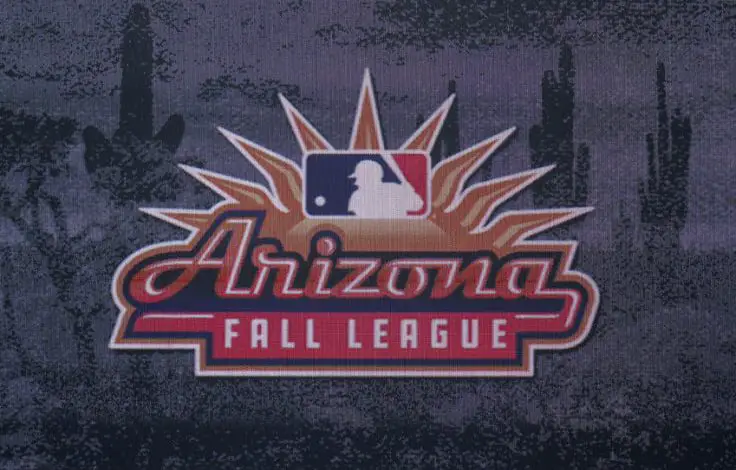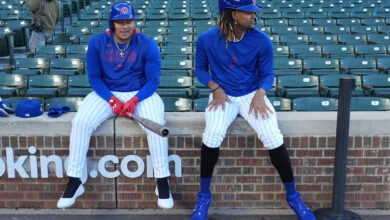
How Will Cubs Determine Which Prospects to Send to Arizona Fall League?
Major League Baseball announced Wednesday that the Arizona Fall League (AFL) would be back this year and will run from mid-October to late November. Normally it showcases some of the game’s top young prospects, most of whom have at least played at High-A. The news was pretty well received because of the shortened minor league season and rash of injuries this season.
The Cubs can send seven prospects to play for the Mesa Solar Sox, who play at the Cubs’ spring training facility at Sloan Park. Kris Bryant, Ian Happ, Kyle Schwarber, and Nico Hoerner are among the names who’ve graced AFL rosters of the past, with Schwarber famously stopping in for a little tuneup prior to joining the Cubs in Cleveland for the World Series.
For those who may not be entirely familiar with it, there are several reasons a prospect would be chosen to play in the prestigious league. One is that they are in consideration for a spot on the 40-man roster and the Cubs needed more data against better competition. Sometimes a player heads to Arizona to advance their development against the better prospects or to make up for lost time due to an injury.
It might even be a matter of changing positions, whether it’s from starter to reliever or outfielder to infielder and vice versa. Similarly, a player might go to Arizona to work on swing changes or to develop a certain pitch or a new delivery. Maybe it’s a matter of showcasing a player as a potential trade chip in the winter. My personal favorite motivation is to give a player a head start for Double-A because that is the level of competition they would be facing in the AFL.
As you can see, the great number of factors involved in these decisions make it extremely difficult to come up with a list of names the Cubs might be looking to send to the AFL at this point. We’ll have a much better idea of how things look by September, but we can still look at some of the prospects who look like strong candidates.
The Cubs recently acquired Bryce Ball in the trade with the Braves and they might want to get more of a look at him or make some tweaks to his swing. He’s got a ton of power and appears to have an excellent plate approach, but his swing path is a little long and could leave him susceptible to offspeed stuff. There will likely be other players acquired by the end of the month, so Ball might not be the only new face the Cubs send to Arizona.
The rash of injuries devastating the system this summer will also color the Cubs’ decisions. Just this past Tuesday, 2019 draft pick Chris Clarke debuted in Arizona and threw three scoreless. Armed with a beautiful curveball and slider, Clarke is one of my favorite pitchers in the organization and is the perfect candidate to make up for some lost time.
Miguel Amaya played in the AFL in 2020 and might return if he’s able to get back to full health by then. Brailyn Márquez is in the same boat, along with Michael McAvene and Riley Thompson, as the Cubs will want some of their stud pitchers to get a little competition after missing all of 2020 and this season for various reasons.
The main factor when it comes to who the Cubs send to Mesa is simply how much time is left in the season. Should struggling guys like Christopher Morel and Chase Strumpf need to go? Is Dakota Chalmers going to be a guy that they want to add to the 40-man roster? Brennen Davis is destroying Double-A pitching right now and certainly doesn’t look like he needs a boost, but a trip to Arizona to make up for the month he lost after getting hit in the face in spring training isn’t out of the question.
Brennen Davis oppo again On an off speed pitch pic.twitter.com/bdEY2CpkHh
— Todd ⚾️🐻🦌 (@CubsCentral08) July 22, 2021
It’s rare for the Cubs to send a recent draft pick to Arizona, but I could see them pushing two of their college selections into deeper waters to see how they far. Outfielder Christian Franklin and catcher Casey Opitz were teammates at Arkansas and could pair up in Mesa if the Cubs want to speed up their development and have them ready to start at Double-A next year. While that’s a bit of a stretch, it’s something to consider.
Again, there are just so many variables here that setting forth a definitive list of potential prospects is impossible. It’s still fun to think it over though, especially since it’s looking like the organization will be heavily focused on the future once August hits.

